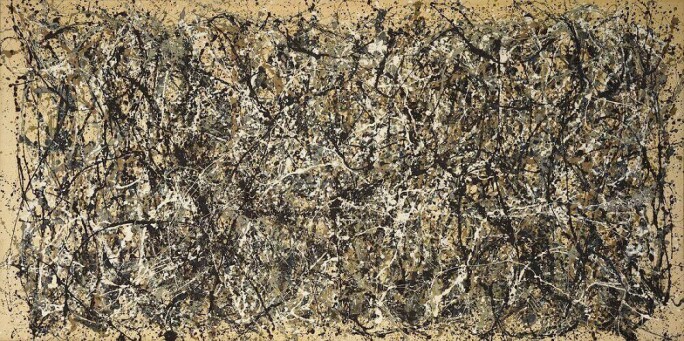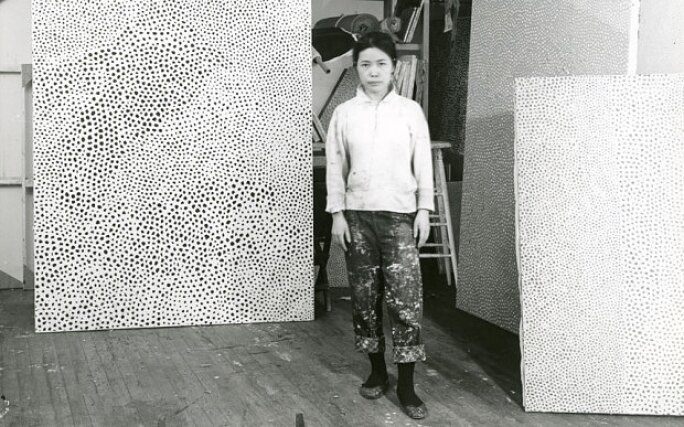T he stark monochrome gravity of the snow-white Infinity-Nets (RAZX) from 2011 evinces a singularly breath-taking visual and visceral dynamism – a quaking shudder that ripped through the New York and European art scenes when the artist’s white nets first appeared over five decades ago. A testament to Yayoi Kusama’s most celebrated corpus of paintings, the present work is captivating in its level of detail; an endless maze of oscillating, kaleidoscopic white lines floating atop a luminous grey-blue background. While many of her later Infinity Nets paintings have taken on a change in colour palette, white is the ultimate emblem to signify Kusama’s original success. As the millennium embarked, Kusama would pay an increasingly large amount of time to installation and sculptural works, making the Infinity Nets fewer in numbers. Measuring around 160 by 160 centimetres, the square shaped Infinity-Nets (RAZX) is without a doubt a signatory work to evoke the spiritual presence of the original series. Filling up our entire field of vision, the apparent uniformity of the over-a-metre net belies minute differences in the size of the individual loops and the quantity of paint utilised in every stroke. Rendered in acrylic, the textural surface of the present work reflects an aesthetic refinement seen upon the artist’s move away from the use of oil paint upon her return to Japan in the 1980s.
The expression transcends the question of whether [the art] is Oriental or American. Although it is something of both, certainly of such Americans as Rothko, Still, and Newman, it is not at all a synthesis and is thoroughly independent. [Kusama’s Infinity Nets] are advanced in all respects; the great frontality, the relative lack of tone, the dual economy and complexity of the structure, the importance of the single stroke, whose multiplicity is so essential here, and the colour and detail as surface itself. The expression is cool and tough; its vast generality is achieved through a precision and an individuality of statement.
Full of reflected light and the artist’s labyrinthine web of mesmeric pigment loops, Infinity Nets (RAZX) exudes an irrepressible and hypnotically irresistible force. Drawing the viewer towards the shimmering spaces contained within the tightly woven blanket of paint, the present work’s almost topographical surface meanders across the extent of the picture plane, mirroring the painterly process by which it was created. Kusama’s innumerable brushstrokes pile onto one another, culminating in some parts of the canvas in mounds of expressive impasto, and solidifying into radiating planes of white pigment in others. Each dab of paint is laid with a painstaking devotion to the act of mark-making, consuming the canvas in a field of texture.

Collection of Museum of Modern Art (MoMA), New York, USA
© Artists Rights Society (ARS), New York
When Kusama first arrived in New York City in June 1958, she recalls climbing to the top of the Empire State Building and looking down at the grided city below in complete awe. At 29 years old, the young artist realised that in order to succeed in the city she would have to do something spectacular: “I aspired to grab everything that went on in the city and become a star” (the artist, quoted in “Interview with Akira Tatehata”, Laura Hoptman, Ed., Yayoi Kusama, London 2000, p. 11). According to art historian Mignon Nixon, Kusama set out to “replace the expressive gesture with an exhaustive one, pushing painting to its limits of spatial extent and ‘monotony;’ and to obliterate the self, reconceiving contemporary painting from a subjective statement of individual consciousness to ‘nothingness’ on an epic scale” (Mignon Nixon, “Infinity Politics,” in Francis Morris, Ed., Yayoi Kusama, London 2012, p. 180). Shortly after, Kusama began work on what would become her most rarefied and renowned series of white Infinity Nets canvases, a prized body of early paintings of which examples reside in some of the most renowned museums and institutions in the world.

After leaving Japan, Kusama abstracted the naturalistic themes of her early works into large-scale canvases with dense repetitive patterns. Inspired by microscopic and macroscopic imagery of nature, these breath-taking extractions became physical manifestations of the artist herself, extending out from her very body: "My nets grew beyond myself and beyond the canvases I was covering them with. They began to cover the walls, the ceiling, and finally the whole universe. I was always standing at the centre of the obsession, over the passionate accretion and repetition inside of me."(the artist, quoted in “Kusama interviewed by Gordon Brown, 1964” in Laura Hoptman, Ed., Yayoi Kusama, London 2000, p. 10).

It was in 1959 that Kusama exhibited her first Infinity Nets paintings in New York, radically transforming the monochrome genre championed by contemporary Abstract Expressionists into a complex vehicle of self-expression. Responding to the emotionally charged brushwork of the likes of Jackson Pollock and Willem de Kooning, Kusama’s repetitive monochromatic patterns ripple with psychological intensity, a uniquely realised manifestation of the artist herself. The impact of this series cannot be understated, in America as well as abroad. The following year in 1960, it was Kusama and Mark Rothko who were featured as the only American artists in a seminal exhibition of Monochrome paintings at the Städtisches Museum in Leverkusen in Germany. Disappearing into the "monotonous, solitary act" (Laura Hoptman, Ed., Yayoi Kusama, London 2000, p. 10) of these paintings, the Infinity Nets series is widely regarded as the most archetypical representative of all of Kusama's celebrated creations.
Extensively considered Japan's greatest living artist today, Kusama reveals her singular vision through various forms and media, exploring infinity net patterns in sculptures, paintings, happenings and films. As a consummate example of the artist’s exploration of the eternal and infinite, Infinity Nets (RAZX) radiates with the essence of the series which is inextricably linked to the artist herself.
潔
白如雪的《無限的網(RAZX)》於2011年面世,以存在感極重的鮮明單色風格,展現令人屏息靜氣的奇異視覺與內在動感。因此,逾半世紀前,當草間彌生的白色網狀圖案首次出現在紐約和歐洲的藝術舞台,引起的顫動就如地震般蔓延,深深撼動人心。本作是草間彌生最享負盛名的畫作系列中的典範,箇中細節豐富,令人着迷;變幻萬千的白色線條迴旋交錯,在一片明亮的灰藍背景中漂浮,彷如無盡迷宮。藝術家不少後期的《無限的網》系列畫作改用不同色調,然而白色始終是她最初的成就的終極象徵。踏入千禧年,草間彌生將越來越多時間投放於裝置藝術和雕塑作品上,《無限的網》系列創作量亦隨之減少。此一正方形的《無限的網(RAZX)》尺寸約160 x 160公分,重現原始系列的精神風貌,因此別具意義。這幅長闊均逾一米的巨網佔據觀者整個視野,表面看來勻稱一致,實則蘊藏微妙差異。靜心細看,每圈網格的形狀大小、每道筆觸的顏料用量,各有不同。本作以壓克力彩繪製,顏料帶來的特殊表面質感,反映藝術家在1980年代回到日本後逐步棄用油彩的美學進化過程。
《無限的網( RAZX)》畫面滿載反射的光芒,以迷幻的顏料點塊組成如迷宮般的網格,滲透出一股帶有催眠力量、難以抑制的不可抗力。觀者的視線,不期然被編織綿密的顏料之網,以及其中閃亮的空間所吸引。彷如地形般的表面綿延整幅畫作,透視出其繪畫創作的過程。藝術家數之不盡的筆觸,在畫布上反覆堆疊,慢慢形成個別富張力的厚塗丘峰,其餘則凝固成明亮的白色顏料色塊。每一點的顏料,均以無比的專注畫成一道道標記,將畫布變成一片充滿肌理質感的原野。
據草間憶述,她在1958年6月離開日本抵達紐約時,曾登上帝國大廈的頂樓,滿懷驚嘆地俯視下面的城市網絡。當時29歲的年輕藝術家意識到,要在這城市出人頭地,便必需作一番驚天動地的大事。「我決定抓緊這城市的一切機會,成為一顆明星」(引述藝術家,錄於〈與建畠晢訪談〉,蘿拉·霍普特曼編,《草間彌生》,倫敦,2000年,頁11)。據藝術史家米尼翁·尼克遜所述,草間決心「以竭斯底里的姿態代替抒情,將繪畫的空間和單一性推至極致,從而消融自我,以史詩般宏大的方式演繹個人意識至『無』的狀態,從主觀角度重新構思當代繪畫」(米尼翁·尼克遜,〈無限政治〉,弗朗西斯·莫里斯編,《草間彌生》,倫敦,2012年,頁180)。不久之後,草間便開始創作一系列白色的《無限的網》作品。這些備受讚譽的草間早期佳作,如今已成為她最稀有和著名的藝術系列,當中不少作品均被世上最著名的博物館和機構收藏。
從美學角度而言,這些網狀物可以追溯至草間早期的日本畫訓練——一種傳統的日本式自然風格繪畫。離開日本後,草間將她早期作品的自然主題抽象化,將密集重複模式套用到大型畫布之上。受微觀及宏觀的自然圖像所啟發,這些令人讚嘆的濃縮選材,成為一種從藝術家本人身體而來的物理表現宣言:「這些網超越我的身體和畫布,慢慢覆蓋牆身、天花,以至整個宇宙。我總是抱持著對增生和重複的熱情,站在這執念的中心」(引述藝術家,錄於〈1964年草間與戈登·布朗訪談),蘿拉·霍普特曼編,《草間彌生》,倫敦,2000年,頁10)。
1959年,草間首次在紐約展出她的《無限的網》畫作,一舉將當時由抽象表現主義者主導的單色藝術,顛覆為一種自我表述的複雜載體。作為對傑克森·波拉克和威廉·德庫寧等人充滿情感的筆觸的回應,草間重複的單色構圖滲透出強烈的內心情緒,宣示藝術家獨一無二的個人表述,這系列在美國及世界均引起極大迴響。翌年,德國萊沃庫森市立博物館舉辦一個以單色繪畫為主題的重要展覽,參與的美國藝術家只有草間和馬克·羅斯科二人。彷彿叫人消弭在這些畫作「單調、孤獨的行為」(蘿拉·霍普特曼編,《草間彌生》,倫敦,2000年,頁10)之中,《無限的網》被視為草間所有創作中最具典範代表性的系列。
作為日本最偉大的在世藝術家,草間一直透過不同形式和媒介呈現她獨一無二的藝術視野,孜孜不倦地透過雕塑、繪畫、偶發藝術和電影探索無限的網狀紋理。《無限的網( RAZX)》象徵著草間對永恆和無限命題的探索,完美地呈現出系列精神以及與藝術家本人千絲萬縷的關係。